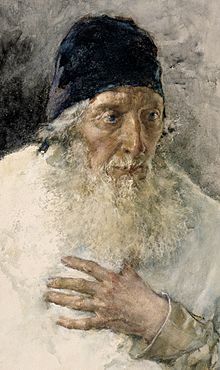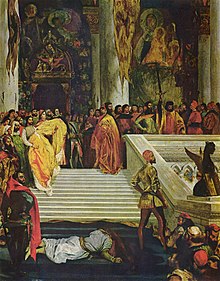Marino Faliero
Marino Faliero | |
|---|---|
 Marino Faliero, Dux LV by Francisco Pradilla Ortiz (1883, Museo del Prado) | |
| 55th Doge of Venice | |
| In office 11 September 1354 – 15 April 1355 | |
| Preceded by | Andrea Dandolo |
| Succeeded by | Giovanni Gradenigo |
| Personal details | |
| Born | 1274[1] Venice, Venetian Republic |
| Died | 17 April 1355 (aged 81) Venice, Venetian Republic |
| Spouse(s) | Tommasina Contarini Alvica Gradenigo |
| Children | 2 |
| Profession | Patrician, statesman |
Marino Faliero (1274 – 17 April 1355) was the 55th Doge of Venice, appointed on 11 September 1354.
He was sometimes referred to simply as Marin Falier (Venetian rather than standard Italian) or Falieri.[2] He was executed for attempting a coup d'etat.[3]
Early life
[edit]

Faliero was the son of Iacopo Marin and Beriola Loredan. He had an uncle of the same name with whom he is often confused.
In 1315 Faliero was one of the three heads of the Council of Ten when it was punishing the organizers of the 1310 Tiepolo conspiracy. Faliero continued as a member of the council until 1320 and held the office of chief and inquisitor several times. In 1320 he was charged with Andrea Michiel to organize the killing of Tiepolo and Pietro Querini, the only two leaders of the conspiracy still at large.
In 1323 Faliero was appointed captain and bailo of Negroponte. In 1326 he was again in Venice as a member of the Council of Ten, but the following year he left for Bologna on a mission to the prior of the Servites who had a dispute with Venice. Back again in the Ten, he left shortly after to be elected one of the Five Elders to Peace, another group of Venetian magistrates. After a few years of absence from public life, he reappears again in 1330 as a member of the Council of Ten.
In 1333 he became captain of the galleys of the Black Sea and of Constantinople and protected the merchants going to Tanais. In 1338, he served as podesta of Padua. In 1352 Faliero was sent on a diplomatic mission and met with the Bulgarian Tsar Ivan Alexander in Nicopolis, giving him a letter from the doge Andrea Dandolo.
Doge of Venice
[edit]Faliero was a naval and military commander and then a diplomat before being elected doge in succession to Andrea Dandolo.[4] He learned of his election while he was on a diplomatic mission to the papal court at Avignon.[4] The populace of Venice was at that time disenchanted with the ruling aristocrats who were blamed for a recent naval defeat by the fleet of the Republic of Genoa at the 1354 Battle of Portolungo during the Third Venetian–Genoese War.[4]
Within months of being elected, Faliero attempted a coup d'etat in April 1355, aiming to take effective power from the ruling aristocrats. According to tradition, this came about because the dogaressa, Faliero's second wife, Aluycia Gradenigo, had been insulted by Michele Steno, a member of an aristocratic family,[5] but in a study of doges of Venice Antonella Grignola suggests that Faliero's move was consistent with a prevailing trend in Italian cities to move away from oligarchic government to absolute, dynastic rule.[5]
The plot intended to murder the chief patricians on 15 April and proclaim Faliero prince of Venice. It was badly organised, with poor communication between the conspirators, and was quickly discovered thanks to some of the conspirators having made revelations. The Council of Ten proceeded to arrest the ringleaders and to place armed guards all over the town. Several of the conspirators were condemned to death and others to various terms of imprisonment. Faliero pleaded guilty to all charges and was beheaded on 17 April[2][6] and his body mutilated. Ten additional ringleaders were hanged on display from the Doge's Palace in Piazza San Marco.[7]
Legacy
[edit]
Faliero was condemned to damnatio memoriae, and accordingly his portrait displayed in the Sala del Maggior Consiglio (Hall of the Great Council) in the Doge's Palace was omitted and the space painted over with a black shroud, which can still be seen in the hall today. A Latin language inscription on the painted shroud reads: Hic est locus Marini Faletro decapitati pro criminibus ("This is the space for Marino Faliero, beheaded for his crimes").[5]
The story of Faliero's failed plot was later made into plays by Lord Byron (Marino Faliero, Doge of Venice in 1821) and Casimir Delavigne (in 1829).[8][9] The latter's inspired by the former's version was adapted into an eponymous opera scored by Gaetano Donizetti in 1835.[9] All three present the traditional story that Faliero was acting to defend his wife's honour.[8][9] Prussian author E. T. A. Hoffmann used a different approach in his 1818 novella Doge und Dogaresse; German composer Robert Schumann contemplated writing an opera based on Hoffmann's story.[10] Eugène Delacroix's 1826 painting The Execution of the Doge Marino Faliero is based on Lord Byron's play.[11]
His home, Palazzo Falier, still exists in Venice, being one of the oldest structures there.[12][13]
Notes
[edit]- ^ "Marin Falier". Encyclopædia Britannica. Retrieved 7 March 2017.
- ^ a b Villari, Luigi (1911). . In Chisholm, Hugh (ed.). Encyclopædia Britannica. Vol. 10 (11th ed.). Cambridge University Press. p. 148.
- ^ Says, Venice Fan (17 April 2009). "ExecutedToday.com » 1355: Marino Faliero, Doge of Venice". Retrieved 31 August 2021.
- ^ a b c Grignola, p. 48
- ^ a b c Grignola, p. 49
- ^ Byron, Lord George (1842). Marino Faliero ... An historical tragedy, in fife sic acts, of Lord Byron. John Murray. p. 157.
- ^ Norwich, pp. 223–229
- ^ a b Lefevre, Carl. "Lord Byron's Fiery Convert of Revenge", Studies in Philology , Vol. 49, No. 3 (July 1952), pp. 468–487 (subscription required)
- ^ a b c Ashbrook, William. "Marino Faliero", The New Grove Dictionary of Opera', Oxford Music Online, accessed 17 June 2012 (subscription required)
- ^ Jensen, Eric Frederick (13 February 2012). Schumann. Oxford University Press. ISBN 978-0-19-983068-8.
- ^ Jonker, Marijke (2010). "'Crowned, and Discrowned and Decapitated': Delacroix's the Execution of the Doge Marino Faliero and its Critics". Nineteenth-Century Art Worldwide. 9 (2).
- ^ "Cannaregio district". VeneziaUnica City Pass. 27 February 2018. Retrieved 7 October 2019.
- ^ Buckley, Jonathan (2013). The Rough Guide to Venice & the Veneto. Rough Guides UK. p. 129. ISBN 9781409366461.
Bibliography
[edit]- Ashbrook, William (1996). "Marino Faliero". The New Grove Dictionary of Opera.
- Brown, H. (1907). Studies in the History of Venice. London: John Murray.
- Grignola, Antonella (1999). The Doges of Venice. Venice: Demetra. ISBN 9788844014131.
- Norwich, John Julius (2003) [1977]. A History of Venice. London: Penguin. ISBN 978-0-14-101383-1.
- Lazzerini, V (1892). Genealogia d. M. Faliero. Archivio Veneto.
- — (1893) "M. Faliero avanti ii Dogado," ibid.
- — (1897) "M. Faliero, la Congiura," ibid.
- Ravegnani, Giorgio (2017). Il traditore di Venezia: Vita di Marino Falier doge (in Italian). Bari and Rome: Editori Laterza. ISBN 978-88-581-2715-5.
- Romanin, S. (1855). Storia documentata di Venezia. Vol. lib. ix. Venice.
{{cite book}}: CS1 maint: location missing publisher (link) - Sanudo, M. (1900). Le Vite dei Dogi (Muratori fasc. ed.). Citta di Castello.
{{cite book}}: CS1 maint: location missing publisher (link)
- 1274 births
- 1355 deaths
- 14th-century Doges of Venice
- 14th-century executions
- Damnatio memoriae
- Executed heads of state
- Executed Italian people
- 14th-century Italian diplomats
- People executed by decapitation
- People executed by the Republic of Venice
- Republic of Venice military personnel
- Burials at Santi Giovanni e Paolo, Venice
- Baili of Negroponte
- Ambassadors of the Republic of Venice to the Holy See
